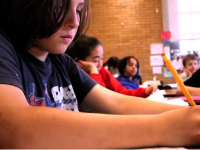6 Rules to Break for Better, Deeper-Learning Outcomes
Incorporate deeper learning as you empower students to seek knowledge from many sources, use tools relevant to their lives, and embrace the lessons of failure.
As educators, we know when students tune in -- and we know when they tune out. The more elusive question is why. There is emerging consensus that the 20th-century approach to education, which favors methods such as lectures and rote learning, is standing in the way of making school relevant to more students.
Fortunately, research is catching up with our intuition and validating the practices that we know work in the classroom. One vision in particular, about what students should be able to do and know, is picking up steam. It's called deeper learning.
The Benefits
Deeper learning is a set of learning outcomes for students that include:
- Mastery of core academic content
- Critical thinking and problem solving
- Productive collaboration
- Effective communication
- An ability to direct their own learning and exhibit a strong academic mindset.
And the practices that support these outcomes are not only necessary for engaging students, but they're also effective -- with all students.
You don't have to take my word for it. A recent rigorous and quantitative study by the American Institutes of Research (AIR) demonstrates the effectiveness of schools that are designed to develop these outcomes.
The study found that deeper learning public high schools graduate students with better test scores and on-time graduation rates nine percent higher than other schools, a win for teachers and students alike. Graduates of the deeper learning schools were more likely to enroll in four-year colleges, attend selective schools, and report higher levels of academic engagement and motivation to learn. Perhaps most importantly, deeper learning benefits students regardless of their background or incoming achievement levels.
The Rules
So how can educators achieve these 21st-century outcomes and turn the proverbial apple cart upset down? Let's start by breaking the rules of the 20th century's all-expansive curriculum where students "sit and get."
While the AIR study gives a glimpse of these practices, I’ve come up with six rules teachers can help students break, adapted from my book, Deeper Learning: How Eight Innovative Public Schools Are Transforming Education in the 21st Century:
1. Don't learn from just me.
Teachers are only one source of knowledge. Students at Avalon School in St. Paul, Minnesota learn filming from a local nonprofit in the area, and students at Science Leadership Academy in Philadelphia learn from scientists and researchers at the Franklin Institute through mini-courses.
2. Learn what you want to learn.
Encourage students to take responsibility for their own learning by pursuing their interests. A first-generation Guatemalan student at MC2 STEM High School in Cleveland, Ohio had a love for math. By sophomore year, he had mastered all of his high school classes and decided to take math courses at Cleveland State University. He ended up taking several advanced engineering classes there, including engineering design, programming with math lab, statistics, multivariate calculus, differential equations for engineering, and physics.
3. Use social media in school, too.
Blogging, Twitter, and Facebook aren't just for selfies! Students can use social media for multiple purposes. Students at King Middle School in Portland, Maine are Skyping with authors of the books they read in English or history classes, and students in the technology education class learn about the design process through a YouTube video of engineers from IDEO who spent a week redesigning a shopping cart. Students in an English class at Science Leadership Academy in Philadelphia use Wikispaces to give and receive feedback on each other's poetry.
4. Don't quietly wait to be told what to do.
Provide opportunities for students to turn their interests into learning endeavors as projects. For his senior project, a Casco Bay High School (CBHS) student in Portland, Maine developed and led a literacy project that involved other Casco Bay students in designing original comic books to help Nicaraguan elementary students learn English. After using the comic books to teach those children, the CBHS student engaged them in designing comic books to help students in his own school learn Spanish.
5. Learn outside of school.
Help students identify resources beyond what the school can provide as a way to enhance their learning. Students from Rochester High School, located in a rural area two hours north of Indianapolis, earn up to 30 college credits by taking courses online from Tri-County College. Juniors from High Tech High in San Diego, California chose from over 600 possible internship placements in which they have to complete the full 140 hours to receive credit toward graduation.
6. Fail, then try, try, and try again.
Failure is a process for real learning and achievement. Freshmen in Phil Bucard’s engineering class at MC2 learn about failure through the use of the engineering process. After the freshmen spent weeks learning about design principles used to build bridges, they built their own model bridge and tested it on a shaker table at NASA. If or when the bridge collapsed, the teacher and engineers used the failure as an opportunity to talk to students about the need to constantly "prototype" or test their work and improve upon it.
Relevant Learning
There is an evolving research base that continues to validate what happens in the classroom when we reimagine teaching and learning to be more active and relevant. So go ahead and break rules, particularly those 20th-century rules that stop us from moving to a place where students not only tune in, but are empowered to self-direct their learning.
The aforementioned rules are just the start. Tell me what rules you think we need to break to bring teaching and learning into the 21st century?
